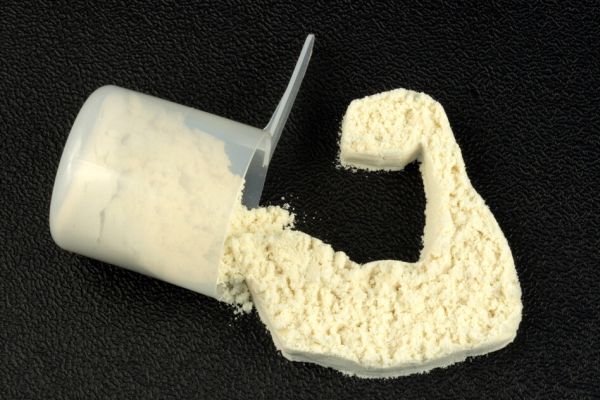If someone feels they’re carrying about too much fat, they’ll probably say they need to lose some weight.
Ironically, if that’s their only goal–reducing the number on the scale–they’re like to run into a new problem along the way: becoming skinny fat.
You see, the phrase “weight loss” is tossed around by just about everyone, including myself, but what we really want is a bit more than that.
We don’t want to just “lose weight”–we want to reduce our body fat percentage and thus improve our body composition. That is, we want to reduce our total amount of body fat without reducing our total amount of lean mass.
If this is obvious to you, you’re in the minority. Most people don’t realize how much muscle they can lose with a poor “weight loss” diet and exercise routine and are puzzled when they succeed in losing weight only to be disappointed by a weak, soft physique staring back at them in the mirror.
Well, in this article we’re going to talk about how to do “weight loss” properly: how to lose body fat and not muscle and get that tight, muscular look you’re actually after.
- When "a Calorie Is a Calorie"...and When It Isn't
- How to Lose Body Fat and Not Muscle: Use a Modest Calorie Deficit
- How to Lose Body Fat and Not Muscle: Follow a High-Protein Diet
- How to Lose Body Fat and Not Muscle: Do Strength Training
- How to Lose Body Fat and Not Muscle: Use Cardio Sparingly
- What did you think of this article on how to lose body fat and not muscle? Have anything else to share? Let me know in the comments below!
Table of Contents
Want to listen to more stuff like this? Check out my podcast!
When “a Calorie Is a Calorie”…and When It Isn’t
Like the ridiculous anti-sugar hysteria and low-carb worship that are currently in vogue, various diet “experts” are also claiming that weight loss isn’t as simple as eating less energy than you expend. That you can’t simply get there with proper meal planning and restricting calories.
Instead, these ignoramuses and shysters claim, all you have to do to lose weight is avoid foods that cause “hormonal clogging” (whatever the hell that is) or large insulin spikes or other physiological voodoo or eat foods somehow conducive to weight loss due to efficient processing or even metabolic acceleration.
These types of sales pitches sound pretty good to the “get rich quickers” of the fitness space. You know, the people that always talk about wanting to get fit but don’t want to regulate food intake or exercise much and thus are always on the hunt for that “one weird trick” that will “melt off the belly fat.”
Well, I’ve written about the indisputable physiology of the metabolism and the science of proper calorie counting for weight loss in quite a few other articles, so I won’t review it all here.
Instead, in this article I want to focus on a paradoxical aspect of “calories in versus calories out.” Namely…
When we’re just talking about weight loss, it all boils down to maintaining a negative energy balance. Consume less energy via food than you expend over time, and your weight will go down.
What you eat to get in those calories doesn’t matter–a calorie is a calorie in this sense. Professor Mark Haub lost 27 pounds on a diet of protein shakes, Twinkies, Doritos, Oreos, and Little Debbie snacks, and you could do exactly the same if you wanted to.
Hell, if you really want to speed things up, severely restrict your food intake as well and you could drop as much as 5 pounds per week for the first few weeks at least.
If you did these things, however, you would run into several problems including muscle loss, which brings me to my next point…
When we’re talking about losing just body fat and not muscle, however–improving body composition–we must not only maintain a negative energy balance, but we must do so with a proper balance of macronutrients.
You see, when the goal isn’t to merely weigh less but to have a lower body fat percentage with all the muscle you currently have (or more), getting the majority of your calories from junk carbs and fats and starving yourself will no longer cut it. A calorie is no longer a calorie because some types of calories are now much more important than others.
So then, let’s get to the details on how to lose body fat and not muscle, starting first with the all-important calorie deficit.
How to Lose Body Fat and Not Muscle:
Use a Modest Calorie Deficit

As mentioned earlier and discussed in much detail in my other weight loss articles, losing fat requires that you consume less energy than you expend. When you do this, you’re creating what’s known as a “calorie deficit.”
Calorie restriction is a double-edged sword, however because while it will always reduce fat mass, it can also reduce lean mass if you don’t go about it correctly.
The biggest mistake you can make is severely restricting your calories. That is, maintain too large of a calorie deficit (eat too little) every day and you’ll start burning up muscle as well as fat (especially if you don’t exercise).
What is a severe calorie restriction? Well, while we’ll probably never have a “slam dunk” answer due to variables like genetics, total lean mass, and muscle conditioning, we can take an educated guess.
Based on the literature I’ve read and anecdotal evidence I’ve seen among natural bodybuilders, it would appear that problems can begin when you regularly feed your body less than 70% of the energy it burns (create a caloric deficit over 30%).
To put this in perspective, consider the following:
- A 140-pound woman exercising 3-5 times per week will burn approximately 1,600-1,700 calories per day. If such a woman ate less than, ~1,100 calories per day for a week or two, she would be entering the problem area.
- A 200-pound man exercising 3-5 times per week will burn approximately 2,500-2,600 calories per day. Anything less than ~1,900 calories per day would be under-eating for such a man.
It’s worth noting, however, that these guidelines can be stretched by the severely overweight and obese. Research has shown that the more body fat you have, the larger of a calorie deficit you can maintain without having to worry about excessive muscle loss.
If you’re not sure how to even work out a proper calorie deficit, check this out article of mine on meal planning.
How to Lose Body Fat and Not Muscle:
Follow a High-Protein Diet

Protein is the most important macronutrient to get right when you’re dieting for fat loss and is the real reason why a calorie isn’t a calorie when you want to optimize your body composition.
The research is crystal clear: a high-protein diet…
- Is more effective at reducing body fat, including abdominal fat in particular
- Helps preserve lean mass
- Increase satiety, helping you avoid hunger pangs and cravings
A high-protein diet is even more important if you’re exercising regularly, as this further increases your body’s demand for amino acids.
How much protein should you be eating exactly? Well, if you want the long answer, you can check out the article I wrote on how much protein you need to build muscle, but the short answer is this:
According to recent research conducted by scientists at AUT University…
“Protein needs for energy-restricted resistance-trained athletes are likely 2.3-3.1g/kg of FFM [1 – 1.4 grams per pound of fat free mass] scaled upwards with severity of caloric restriction and leanness.”
I’ve found this to be very true, not only with my body, but with the thousands of people i’ve worked with.
As you get leaner, keeping your protein intake high becomes very important. If it drops too low (below 1 gram per pound of body weight, in my experience), strength and muscle loss is accelerated.
How to Lose Body Fat and Not Muscle:
Do Strength Training

Research has conclusively demonstrated that the most effective way to retain–and even build–muscle while restricting calories is strength training.
By including strength training in the mix, you’ll lose less weight over time than if you didn’t but you’ll lose more fat.
[tweet “By doing strength training, you’ll lose less weight over time but you’ll lose more fat.”]
This is especially true if you’re new to weightlifting as you can actually expect to gain some muscle while losing fat, which further throws off your scale results.
Now, how much weightlifting should you be doing? That depends on your lifestyle and ultimate goal, but even one or two days per week is enough to make sure you lose body fat and not muscle.
How to Lose Body Fat and Not Muscle:
Use Cardio Sparingly

Many people equate cardio with weight loss, and figure the more they do, the more weight they lose.
While cardio does help burn calories and thus fat, and while doing more will result in more calories burned, it’s a big mistake to do an excessive amount of cardio while dieting to lose weight.
Why? There are two primary reasons…
Your body is already under stress due to the caloric deficit, it’s easier to overtrain when you’re dieting to lose body fat.
We experience overtraining in several ways: “burnout,” general fatigue, depression, decreased immunity, and more. It’s no fun.
Well, research has shown that intense, prolonged endurance training is a particularly effective way to induce overtraining.
[tweet “Intense, prolonged endurance training is a particularly effective way to induce overtraining.”]
You’re more likely to experience excessive metabolic slowdown, which can persist long after weight loss is stopped.
These reductions in metabolic rate are one of the things that makes it hard for many people to maintain their new weight after losing a significant amount of fat.
Because their metabolisms have slowed down, and sometimes by quite a bit, they can no longer eat as much as they were used to eating before dieting without gaining weight.
This negative “metabolic adaption,” as it’s known, is accelerated by doing excessive amounts of exercise, and particularly cardio, when you’re in a caloric deficit.
So, while cardio is an effective tool for aiding weight loss, doing a lot of long-duration, steady-state cardio is not the best way of going about it.
Much better is to focus on “high-intensity interval training,” which has you perform shorter, higher-intensity exercise. It’s not only more effective than steady-state cardio for losing fat, but also for preserving muscle.
Personally, I never do more than 4, 25-minute sessions of HIIT per week when I’m in a caloric restriction, and I usually keep it to 3.
What did you think of this article on how to lose body fat and not muscle? Have anything else to share? Let me know in the comments below!
+ Scientific References
- Gergley JC. Comparison of two lower-body modes of endurance training on lower-body strength development while concurrently training. J Strength Cond Res. 2009;23(3):979-987. doi:10.1519/JSC.0b013e3181a0629d
- Boutcher SH. High-intensity intermittent exercise and fat loss. J Obes. 2011;2011. doi:10.1155/2011/868305
- Sumithran P, Prendergast LA, Delbridge E, et al. Long-Term Persistence of Hormonal Adaptations to Weight Loss. N Engl J Med. 2011;365(17):1597-1604. doi:10.1056/NEJMoa1105816
- Lehmann MJ, Lormes W, Opitz-Gress A, et al. Training and overtraining: An overview and experimental results in endurance sports. J Sports Med Phys Fitness. 1997;37(1):7-17. https://www.ncbi.nlm.nih.gov/pubmed/9190120. Accessed November 14, 2019.
- Geliebter A, Maher MM, Gerace L, Gutin B, Heymsfield SB, Hashim SA. Effects of strength or aerobic training on body composition, resting metabolic rate, and peak oxygen consumption in obese dieting subjects. Am J Clin Nutr. 1997;66(3):557-563. doi:10.1093/ajcn/66.3.557
- Bryner RW, Sauers J, Donley D, et al. Effects of Resistance vs. Aerobic Training Combined With an 800 Calorie Liquid Diet on Lean Body Mass and Resting Metabolic Rate. J Am Coll Nutr. 1999;18(2):115-121. doi:10.1080/07315724.1999.10718838
- Helms ER, Zinn C, Rowlands DS, Brown SR. A systematic review of dietary protein during caloric restriction in resistance trained lean athletes: A case for higher intakes. Int J Sport Nutr Exerc Metab. 2014;24(2):127-138. doi:10.1123/ijsnem.2013-0054
- Phillips SM, van Loon LJC. Dietary protein for athletes: From requirements to optimum adaptation. J Sports Sci. 2011;29(SUPPL. 1). doi:10.1080/02640414.2011.619204
- Halton TL, Hu FB. The effects of high protein diets on thermogenesis, satiety and weight loss: A critical review. J Am Coll Nutr. 2004;23(5):373-385. doi:10.1080/07315724.2004.10719381
- Krieger JW, Sitren HS, Daniels MJ, Langkamp-Henken B. Effects of variation in protein and carbohydrate intake on body mass and composition during energy restriction: A meta-regression. Am J Clin Nutr. 2006;83(2):260-274. doi:10.1093/ajcn/83.2.260
- Clifton PM, Bastiaans K, Keogh JB. High protein diets decrease total and abdominal fat and improve CVD risk profile in overweight and obese men and women with elevated triacylglycerol. Nutr Metab Cardiovasc Dis. 2009;19(8):548-554. doi:10.1016/j.numecd.2008.10.006
- Evans EM, Mojtahedi MC, Thorpe MP, Valentine RJ, Kris-Etherton PM, Layman DK. Effects of protein intake and gender on body composition changes: A randomized clinical weight loss trial. Nutr Metab. 2012;9. doi:10.1186/1743-7075-9-55
- Hall KD. What is the required energy deficit per unit weight loss? Int J Obes. 2008;32(3):573-576. doi:10.1038/sj.ijo.0803720
- Ballor DL, Katch VL, Becque MD, Marks CR. Resistance weight training during caloric restriction enhances lean body weight maintenance. Am J Clin Nutr. 1988;47(1):19-25. doi:10.1093/ajcn/47.1.19
- Durrant ML, Garrow JS, Royston P, Stalley SF, Sunkin S, Warwick PM. Factors influencing the composition of the weight lost by obese patients on a reducing diet. Br J Nutr. 1980;44(3):275-285. doi:10.1079/bjn19800042
- Ballor DL, Katch VL, Becque MD, Marks CR. Resistance weight training during caloric restriction enhances lean body weight maintenance. Am J Clin Nutr. 1988;47(1):19-25. doi:10.1093/ajcn/47.1.19











